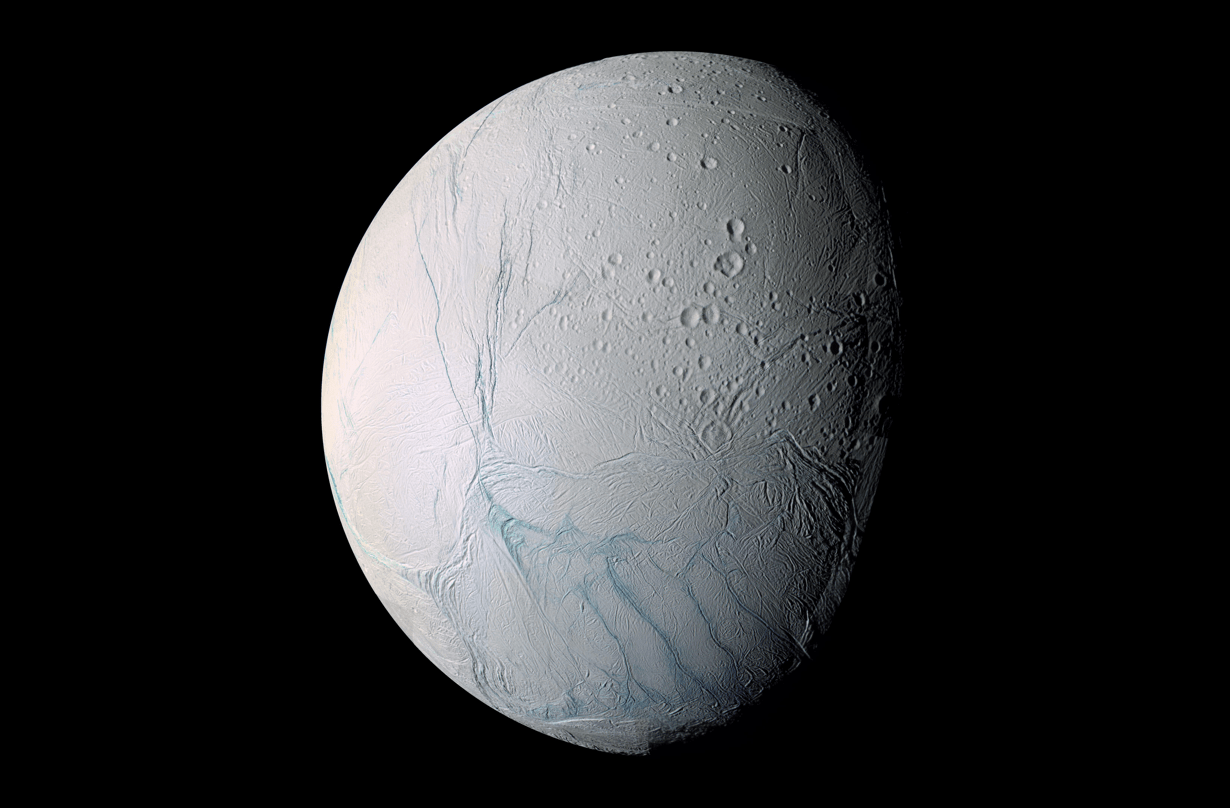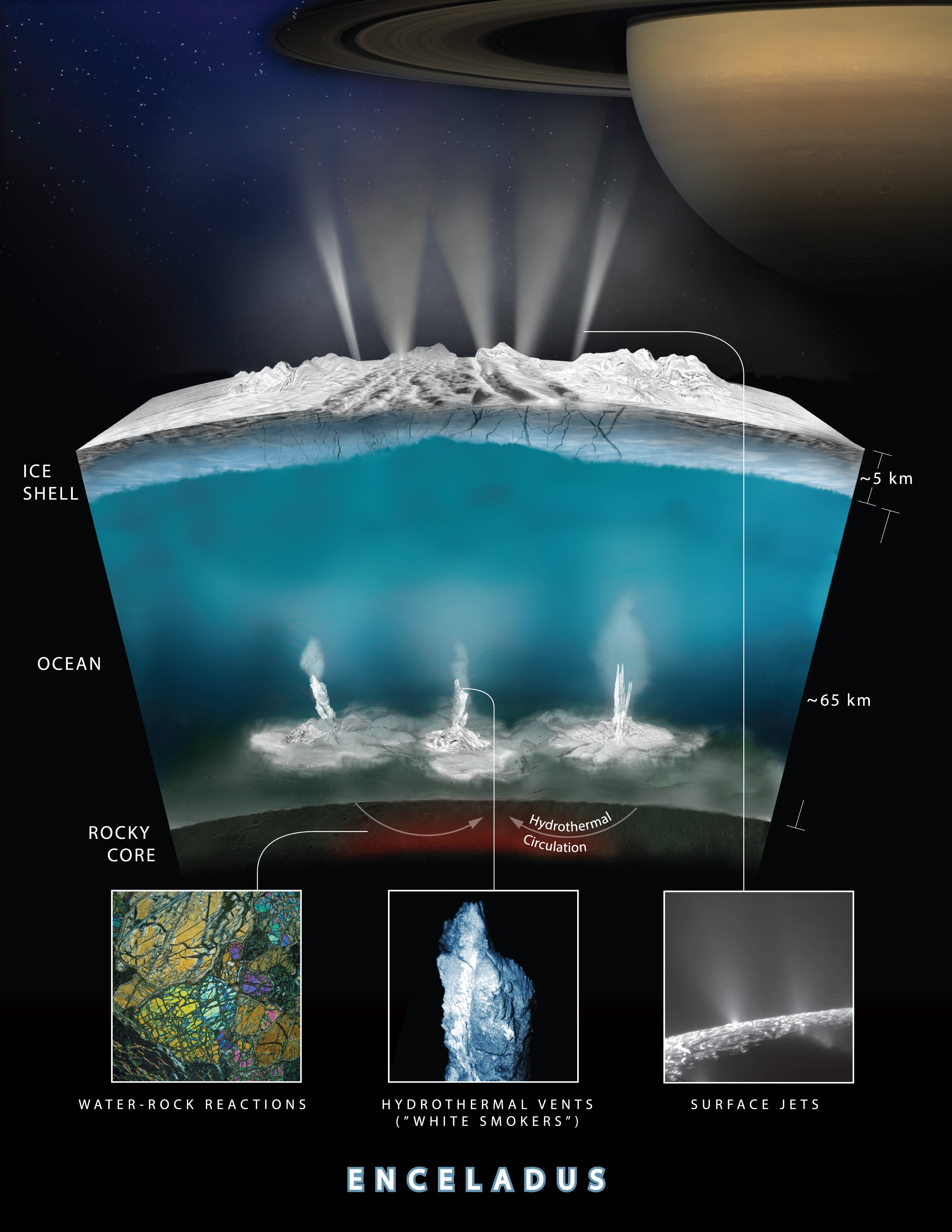Saturn’s Moon Enceladus Becomes A Top Candidate For Life
6:17 minutes

New research from the Cassini mission, published in Science this week, has found new excitement on one of Saturn’s moons: plumes of vapor emerging from Enceladus contain large amounts of molecular hydrogen. More importantly, this hydrogen seems to be the product of hydrothermal activity in the moon’s ocean…and is a strong hint that the moon has conditions favorable to microbial life.
[Here’s what happens after Cassini’s time is up.]
Scott Bolton, a co-investigator for the Cassini mission and co-author on the research, explains why the trail from hydrogen could lead to life, and his hopes for future missions to ocean worlds like Enceladus and Jupiter’s Europa.

Watch NASA’s Enceladus announcement below:
Scott Bolton is Principal investigator on the Juno mission and a Co-investigator on the Cassini mission. He’s Associate Vice President at the Southwest Research Institute in San Antonio, Texas.
SPEAKER 1: Speaking of life on other worlds, new research on data from NASA’s Cassini mission is raising the stakes for Saturn’s moon Enceladus. Not only is it expelling plumes of water vapor from cracks in its icy shell, but these plumes seem to be coming from hydrothermal vents under an ocean, and the plumes are full of hydrogen. If I were a microbe living on a hydrothermal vent on earth, then hydrogen would be a tasty source of energy. Does this mean we might find microbes on Enceladus?
And with a few more insights is Scott Bolton, a co-investigator on Cassini and co-author on the new research in the journal Science. He’s based at Southwest Research Institute in San Antonio. Welcome back to Science Friday.
SCOTT BOLTON: Thank you very much. Great to be here.
SPEAKER 1: Tell us, this was a special kind of hydrogen that Cassini found in these plumes?
SCOTT BOLTON: No, it’s not actually special hydrogen. It’s just the fact that there is this excess hydrogen there that is so interesting. The question is how is it being produced? Where’s it coming from? And is that a hint that maybe this is the food for microbes?
SPEAKER 1: And where do you think it might be coming from?
SCOTT BOLTON: Well, you know, Enceladus is too small to really have a whole bunch of hydrogen that it’s just holding onto, because it doesn’t have the gravity field to hold onto something that is a very, very light element. Hydrogen’s the most common element in the whole universe, but we don’t expect a lot of it sitting on Enceladus. Of course, Enceladus has an ocean. And on Earth, we see hydrogen being produced in hydrothermal activity. In other words, under the deep sea, the water meets the rock, and some chemistry occurs, and hydrogen is released.
And on the Earth, actually, life starts off of this energy or this food source. And so when we see that Enceladus has this hydrogen coming out, it was sort of unexpected. Of course, we were searching for it because of the length to the way Earth works. And we know that it has these deep oceans, and it’s putting out these geysers. And so the idea that we’ve proposed, and we’ve researched a lot of different ideas trying to come up with an alternative theory, is that actually there’s hydrothermal activity going on deep in the ocean on Enceladus, and it may be producing white and black smokers, kind of like what we see on Earth.
SPEAKER 1: And if there are white and black smokers on Earth, there might be what on Enceladus?
SCOTT BOLTON: There might be life. All around these deep vents, we have these big hydrothermal, very deep hydrothermal, vents on the Earth, and we call them white and black smokers because they put out white smoke, or what looks like white smoke, or black smoke depending on how much sulfur is tied into it. But basically what you have is you have minerals that are very rich in iron interacting with water. And when they interact with the water, they form new minerals, and in the process they release hydrogen. And around these vents, these hydrothermal vents on the Earth, we see tons of lifeforms.
This was only discovered a few decades ago, but nobody expected all this kind of life there. And what it– it changed our perspective on the Earth as far as where life is and how common it is, because here was life forming and thriving under the sea where there’s no direct access to sunlight. Before that, I think we had always assumed– scientists had always assumed that sunlight was needed. But here on the Earth, we found lots of life.
It may be one of the ways that life started on the Earth as deep in the ocean, and you don’t need any sunlight at all. You just have the microbes basically feeding off of this hydrogen, and that’s its energy source. And around that region on the Earth in these hydrothermal vents, you find little spider crabs, little shrimp, all kinds of different kinds of mussels.
SPEAKER 1: And so you’re not looking for that kind of stuff? If you go search Enceladus or even Europa, you’re looking for more primitive sorts of things.
SCOTT BOLTON: We’re looking for simple things to measure. To be able to go find a shrimp, we’d have to send a submarine down or something. But when we have water coming out of this ocean spraying out into space, and if you can fly a spacecraft through that water mist, you can go in and measure whether there’s microbes, and amino acids, and other kinds of things that might be present in that water. And so, that’s really what you’re going to go look for is the next step toward habitability, and is there even primitive life going on in there? If there is, I mean you could have a much higher lifeform like a shrimp living there, but we’d have to– the first step is to go find out if you think you see microbes.
SPEAKER 1: Well, are we going to send any probes? Are there plans to send probes either to Enceladus or the other, like Europa, which has an ocean too?
SCOTT BOLTON: Yeah. So Europa has an ocean– these two bodies are considered to be ocean worlds, and that’s something that we’ve recently realized as NASA scientists. That actually it’s more than just the Earth, it’s these moons of the giant planets, the outer planets in particular. So there’s a plan to send a mission to Europa. It’s being designed and built today. It’s called the Europa Clipper. And it would, hopefully, fly through these plumes. We’ve seen some plumes coming out of the ice of Europa through Hubble telescope images. And so we would look for something similar as to what we just saw on Enceladus, and even more.
And on Enceladus, there are some missions being planned now. They’re not approved yet. And they’re being studied to be proposed in the next year or so. And so, one of them would maybe go to Enceladus with a follow-on mission to Cassini.
SPEAKER 1: Scott Bolton, co-investigator on NASA’s Cassini mission out of the Southwest Research Institute in San Antonio. We’ll be paying close attention. Thanks for joining us today.
Copyright © 2017 Science Friday Initiative. All rights reserved. Science Friday transcripts are produced on a tight deadline by 3Play Media. Fidelity to the original aired/published audio or video file might vary, and text might be updated or amended in the future. For the authoritative record of ScienceFriday’s programming, please visit the original aired/published recording. For terms of use and more information, visit our policies pages at http://www.sciencefriday.com/about/policies/
Christie Taylor was a producer for Science Friday. Her days involved diligent research, too many phone calls for an introvert, and asking scientists if they have any audio of that narwhal heartbeat.